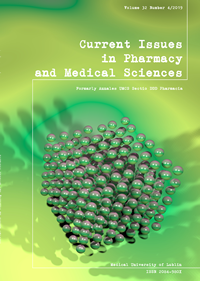Effect of early amniotomy on labor outcome in nulliparous women: a randomized clinical trial
DOI:
https://doi.org/10.2478/cipms-2019-0033Keywords:
amniotomy, Apgar, labor outcomes, postpartum haemorrhageAbstract
Early amniotomy is one of the main interventions to enhance the labor progress and prevent dystocia in pregnant women. However, the efficacy of amniotomy has not been approved via labor-related indices and outcomes and has remained a subject for debate and future research. The present study was conducted to evaluate the effect of early amniotomy on labor indices and outcomes in nulliparous women. This randomized clinical trial was performed on 151 singleton pregnant women who were referred to Besat Hospital in Sanandaj, Iran, from March 2016 to March 2018. Participants were randomly divided into an early amniotomy (EA) group and a control group. Duration of the first and second phases of labor, corioamionit, dystocia rate, Apgar score at the first and fifth minutes, prolonged labor and post-partum haemorrhage were evaluated and compared between the two groups. Data were recorded in a checklist and analysed using SPSS Version 23. The p value <0.05 was considered significant. Results showed that labor indices such as duration of the first and second phases, Apgar score one and five minutes after delivery and frequency of prolonged labor, foetal distress and postpartum haemorrhage were significantly improved in patients of the early amniotomy group, compared with the control group (p≤0.05). Early amniotomy significantly decreased the total labor duration without significant increase in the rate of maternal and neonatal complications.
References
1. Xenakis EM-J, Piper JM, Conway DL, Langer O. Induction of labor in the nineties: conquering the unfavorable cervix. Obstet Gynecol. 1997;90(2):235-9.
2. Vahratian A, Zhang J, Troendle JF, Sciscione AC, Hoffman MK. Labor progression and risk of cesarean delivery in electively induced nulliparas. Obstet Gynecol. 2005;105(4):698-704.
3. Pennell C, Henderson J, O’Neill M, McCleery S, Doherty D, Dickinson J. Induction of labour in nulliparous women with an unfavourable cervix: a randomized controlled trial comparing double and single balloon catheters and PGE2 gel. BJOG: an international journal of obstetrics & gynaecology. 2009;116(11):1443-52.
4. Chard T, Gibbens G. Spurt release of oxytocin during surgical induction of labor in women. Am J Obstet Gynecol. 1983;147(6): 678-80.
5. Onah LN, Dim CC, Nwagha UI, Ozumba BC. Effect of early amniotomy on the outcome of spontaneous labour: a randomized controlled trial of pregnant women in Enugu, South-east Nigeria. Afr Health Sci. 2015; 15(4):1097-103.
6. Cohain JS. Amniotomy and cord prolapse. Midwifery Today with International Midwife. 2013;108:32-33
7. Goffinct F, Fraser W, Marcoux S, Bréart G, Moutquin JM, Daris M, et al. Early amniotomy increases the frequency of fetal heart rate abnormalities. BJOG: an international journal of obstetrics & gynaecology. 1997;104(5):548-53.
8. Fraser WD, Marcoux S, Moutquin J-M, Christen A, Group CEAS. Effect of early amniotomy on the risk of dystocia in nulliparous women. N Engl J Med. 1993; 328(16):1145-9.
9. Ajadi M, Kuti O, Orji E, Ogunniyi S, Sule S. The effect of amniotomy on the outcome of spontaneous labour in uncomplicated pregnancy. J Obstet Gynecol. 2006;26(7):631-4.
10. Ghafarzadeh M, Moeininasab S, Namdari M. Effect of early amniotomy on dystocia risk and cesarean delivery in nulliparous women: a randomized clinical trial. Arch Gynecol Obstet. 2015;292(2):321-5.
11. WHO Reproductive Health Library. WHO recommendation on the use of active phase partograph with a four-hour action line for monitoring the progress of labour. (May 2014). The WHO Reproductive Health Library; Geneva: World Health Organization.
12. Fraser WD, Turcot L, Krauss I, Brisson‐Carrol G, Smyth R. Amniotomy for shortening spontaneous labour. Cochrane Database Syst Rev. 2000 (1).
13. Mercer BM, McNanley T, O'brien JM, Randal L, Sibai BM. Early versus late amniotomy for labor induction: a randomized trial. Am J Obstet Gynecol. 1995;173(4):1321-5.
14. Macones GA, Cahill A, Stamilio DM, Odibo AO. The efficacy of early amniotomy in nulliparous labor induction: a randomized controlled trial. Am J Obstet Gynecol. 2012;207(5):403. e1-. e5.
15. Li N, Wang Y, Zhou H. Effects of routine early amniotomy on labor and health status of foetus and neonate: a meta-analysis. Zhonghua Fu Chan Ke Za Zhi. 2006;41(1):9-16.
16. Levy R, Ferber A, Ben‐Arie A, Paz B, Hazan Y, Blickstein I, et al. A randomised comparison of early versus late amniotomy following cervical ripening with a Foley catheter. BJOG: an international journal of obstetrics & gynaecology. 2002;109(2):168-72.
17. Herbst A, Källén K. Time between membrane rupture and delivery and septicemia in term neonates. Obstet Gynecol. 2007;110(3):612-8.
18. Tran SH, Cheng YW, Kaimal AJ, Caughey AB. Length of rupture of membranes in the setting of premature rupture of membranes at term and infectious maternal morbidity. Am J Obstet Gynecol. 2008;198(6):700. e1-. e5.
19. Lee SM, Lee KA, Lee J, Park C-W, Yoon BH. “Early rupture of membranes” after the spontaneous onset of labor as a risk factor for cesarean delivery. Eur J Obstet Gynecol and Reprod Biol. 2010; 148(2):152-7.
20. Sadler L, Davison T, McCowan L. A randomised controlled trial and meta‐analysis of active management of labour. BJOG: an international journal of obstetrics & gynaecology. 2000;107(7): 909-15.
21. Smyth RM, Markham C, Dowswell T. Amniotomy for shortening spontaneous labour. Cochrane Database Syst Rev. 2013(6).
Downloads
Published
Issue
Section
License
Copyright (c) 2019 Autors

This work is licensed under a Creative Commons Attribution-NonCommercial-NoDerivatives 3.0 Unported License.


